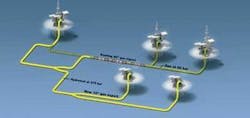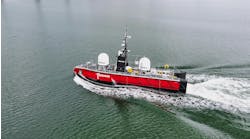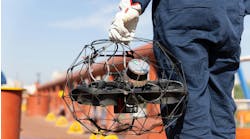Gene Kliewer • Houston
Equipment orders
Aker Kværner has signed a $223-million, three-year frame agreement with Petrobras to supply subsea trees and related equipment in Brazil. The contract comprises 45 subsea trees, six tool sets with related accessories, and spare parts. The equipment is to be managed and completed from Aker Kværner’s facility in Curitiba, Brazil. Delivery is to start 3Q 2009, with final deliveries targeted for the end of 2011.
Aker Kværner, now calledAker Solutions after its recent name change, also landed a contract totaling $50 million for delivery of a deepwater marine drilling riser system, buoyancy package, and related equipment from an unnamed customer. That same customer also agreed to by an additional buoyancy package for a drilling riser it purchased from Aker in 2007.
The riser, destined for a drillship according to Aker, will be 7,500 ft (2,286 m) in length and will be manufactured at Aker’s Malaysia facility. The buoyancy modules will come fromPhoenix Polymers International, which Aker bought controlling interest in last year.
FMC Technologies in Kongsberg has contracted Grenland Group to fabricate, assemble, and test subsea pipe systems as part of FMC’s Woodside Pluto LNG project.
This raises Grenland’s contracts on this job to almost $20.5 million.
Delivery of the structures and pipe systems is scheduled to start in 4Q 2008 and run into 1Q 2009. Pluto is offshore northwest Australia.
Petrobras has ordered 35 km (21.75 mi) of static and dynamic steel umbilicals for $18 million from Prysmian Cables & Systems.
The multi-function umbilicals are part of the Plangas project to increase natural gas production. The project requires electro-hydraulic umbilicals, in eight different configurations to be installed in nine fields in Santos, Campos, and Espirito Santo basins in water depths to 2,000 m (6,562 ft).
The umbilicals will consist of 9 x 10,000 psi (69 MPa) hydraulic lines, 3 x 10,000 psi injection lines, and four pairs of electrical control cables. This contract also will mark one of the first dynamic production super duplex stainless steel tube umbilicals to be installed by Petrobras in Brazil. Ranging in water depths of up to 2,000 m (6,562 ft), the umbilicals will be delivered on a fasttrack following full qualification testing with the first delivery in mid-2008.
Field work
TDW Offshore established its hydro test pressure isolation record of 375 bar (37.5 MPa) in a 20-in. (51-cm) line during a tie in of Caravel and Shamrock fields to the Corvette field pipeline system. TDW says the pressure is equivalent to an axial load of more than 680 tons (617 metric tons).
Schematic for TDW’s tieback Shamrock and Caravel fields to the Corvette pipeline system in the North Sea. The tieback generated the highest pipeline pressure ever isolated by TDW.
TDW, working forShell UK Ltd., used SmartPlug services while connecting a new 16-in. (41-cm) gas export line to the existing infrastructure. Shell also requested certification of the new subsea tie in by hydro testing the new system to 375 bar.
The project consisted of two different pressure isolations. The first was installed at the beginning to isolate the existing pipeline in order to complete the subsea mechanical tie-in. The second isolation was for the hydro test. TDW provided three complete plug trains, each equipped with two isolation modules. One train created double block isolation against existing pipeline gas inventory of 30 bar and the other two created quadruple block isolation against a pressure of 375 bar in the new pipeline.
Elsewhere in the North Sea,StatoilHydro has awarded two contracts to Acergy SA for work on Gjøa and Morvin.
The Gjøa project is pre-installation of static and dynamic umbilicals and flexible risers during 2009 in anticipation of the 2010 hook up to the platform. Gjøa is offshore Norway in blocks 35/9 and 36/7.
At Morvin, Acergy is to install a flexible riser, direct electrical heating riser, dynamic umbilical at Åsgard B, and two static umbilicals from Morvin to Åsgard. Morvin is on 134b in the Norwegian Sea.
As part of its plans to redevelop Anguille field,Total Gabon has begun Phase 1 in an effort to increase oil recovery by 10%, from 13% to 23%. Phase 1 uses existing facilities and calls for drilling of a dozen wells and debottlenecking the surface facilities through this year. Phase 2 entails installation of new offshore infrastructure, decommissioning of obsolete units, and drilling of 30 more wells from 2009 to 2011. Gas flaring also will be eliminated.
Production is expected to increase from 2008, peaking at over 30,000 b/d in 2013-2014. The development cost is estimated at $2 billion for proved and probable reserves of 150 MMbbl.
Anguille is 20 km (12 mi) off Port Gentil in 30 m (98 ft) water depth. It first came on production in 1966 following discovery in 1962.





